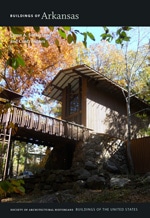In 1930, at the onset of the Great Depression, the population of Little Rock increased when poverty-stricken families from rural areas flocked to the city in search of jobs. Besides meeting the needs of these additional residents, construction of a new U.S. Post Office and Courthouse offered employment opportunities funded by President Franklin D. Roosevelt’s New Deal program. The five-story building with its pedimented pavilions at each end of the facade is a restrained interpretation of Classical Revival, with its spare use of ornamentation a sign of the economic situation. The original rendering of the court-house inspired a protest by Little Rock architect Charles L. Thompson, who presented Supervising Architect Wetmore with a petition criticizing the immature and illogical use of the classical orders, but this had no impact on the final decision, and the original design was retained.
The building has been enlarged and modernized three times. The first addition, a 1941 rear wing on the east side of the building, followed the original 1932 plan and utilized similar materials, ornament, and scale. An 1987 rear wing on the west was comparable in materials and size, but ornament was minimal. In 2005, an annex was situated to the east of the 1941 wing to accommodate twelve new courtrooms and chambers. Constructed of limestone and brick panels with a granite foundation, the five-story annex is in scale with the 1932 core. A new entrance is set within a curved glass-walled atrium that links the old and new buildings. Landscaping in front of the addition includes a water feature designed by landscape architect Mikyoung Kim of Boston. Retention of the 1932 Classical Revival main structure continues to evoke the New Deal federal programs that aided Arkansans during the Great Depression.
























